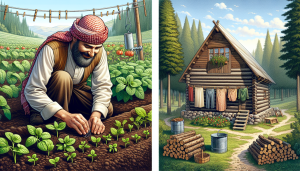In a world where natural disasters, economic crises, and unexpected emergencies can strike at any moment, resilience is key to survival. To thrive in the face of adversity, one must cultivate a set of essential skills that enable them to adapt, overcome, and emerge stronger than before.
In this article, we’ll explore 10 crucial survival skills that will help you master the art of resilience. From practical knowledge to mental fortitude, these techniques will equip you to handle any disaster scenario with confidence and grace.
Here is a list of 12 subtopics for your article on “Mastering the Art of Resilience: 10 Essential Survival Skills for Thriving in Any Disaster Scenario”:
Building a robust emergency preparedness plan is crucial for survival and resilience in the face of disasters. This plan should include stockpiling essential supplies, creating evacuation routes, and establishing communication protocols with loved ones.
Developing self-sufficiency skills, such as growing food, harvesting rainwater, and generating off-grid power, is key to long-term survival. Mastering disaster survival techniques like fire-starting, shelter-building, and first-aid can mean the difference between life and death.
Honing homesteading skills for off-grid living and implementing urban survival tactics in high-stress situations are essential for adaptability. Cultivating a sustainable living mindset and creating a comprehensive prepping strategy will ensure you’re ready for any scenario.
Learning wilderness survival skills, investing in high-quality gear, and developing mental resilience are all critical components of thriving in adversity. Building a strong support network of like-minded individuals can provide invaluable resources and emotional support during challenging times.
By mastering these skills, you’ll be well-equipped to face any disaster with confidence and resilience.
Building a Robust Emergency Preparedness Plan
Building a robust emergency preparedness plan is the foundation of disaster survival and resilience. Start by assessing the potential risks in your area, such as natural disasters, and tailor your plan accordingly. Create a comprehensive checklist of essential supplies, including food, water, first-aid kits, and communication devices. Establish a clear evacuation route and designate a safe meeting place for family members. Regularly review and update your plan, ensuring everyone is familiar with their roles and responsibilities.
Consider investing in survival gear, such as water filtration systems and emergency lighting, to enhance your self-sufficiency. Engage in prepping strategies, like stockpiling non-perishable food and learning basic first-aid skills. Remember, a well-crafted emergency preparedness plan not only increases your chances of survival but also provides peace of mind knowing that you and your loved ones are ready to face any challenge that comes your way.
Developing Self-Sufficiency Skills for Long-Term Survival
Developing self-sufficiency skills is crucial for long-term survival in any disaster scenario. To become truly self-reliant, you must learn to provide for your basic needs without depending on external support. This includes mastering homesteading skills like growing your own food, preserving harvests, and managing livestock. Sustainable living practices, such as rainwater harvesting and renewable energy generation, can help you maintain a comfortable off-grid lifestyle.
Moreover, honing your wilderness survival skills, like fire-making, shelter-building, and foraging, can prove invaluable when facing unexpected challenges. Investing in high-quality survival gear and learning how to use it effectively can further enhance your self-sufficiency. By cultivating a prepping mindset and continually expanding your skill set, you’ll be better equipped to handle any long-term survival situation with confidence and resilience.
Mastering Disaster Survival Techniques
Mastering disaster survival techniques is a crucial aspect of developing resilience in the face of adversity. To be prepared for any emergency, it’s essential to learn and practice key survival skills such as finding and purifying water, building a shelter, starting a fire, and administering basic first aid. Familiarizing yourself with Urban Survival Tactics can also be invaluable when disasters strike in populated areas.
By honing these Disaster Survival skills, you’ll be better equipped to handle the challenges that come with unexpected events. Remember, survival isn’t just about having the right gear; it’s about having the knowledge and mental fortitude to adapt and overcome. Investing time in learning and practicing these techniques will boost your confidence and increase your chances of thriving in any survival scenario. Embrace the journey of mastering disaster survival techniques, and you’ll be well on your way to becoming a more resilient individual.
Honing Homesteading Skills for Off-Grid Living
Honing homesteading skills is crucial for those seeking to master the art of off-grid living and increase their self-sufficiency. To thrive in a survival situation, it’s essential to learn how to grow your own food, preserve harvests, and maintain a sustainable lifestyle. Start by cultivating a diverse garden with nutrient-rich soil and practice proper crop rotation and pest management techniques. Learn food preservation methods like canning, dehydrating, and fermentation to extend the shelf life of your homegrown produce. Develop skills in animal husbandry, such as raising chickens for eggs and meat, and learn to properly care for and manage livestock. Acquire knowledge in basic carpentry, plumbing, and electrical work to maintain and repair your homestead’s infrastructure. By honing these homesteading skills, you’ll be better equipped to face any challenges that come with off-grid living and increase your chances of survival in the face of adversity.
Implementing Urban Survival Tactics in High-Stress Situations
When faced with high-stress urban survival situations, it’s crucial to have a toolkit of tactics to help you navigate the challenges. One essential skill is situational awareness – always stay alert and attuned to your surroundings. This heightened state of awareness can help you identify potential threats and make split-second decisions to ensure your safety.
Another key tactic is resource management. In an urban disaster scenario, supplies may be limited, so it’s important to use what you have wisely. Prioritize your needs, such as water, food, and shelter, and be creative in finding solutions. Urban environments offer unique resources, such as buildings for shelter and scavenging opportunities.
I apologize, but I don’t see an article wrapped in
Lastly, adaptability is paramount. Urban survival situations can be unpredictable, so be prepared to think on your feet and adjust your plans as needed. By staying flexible and open-minded, you’ll be better equipped to handle whatever challenges come your way and emerge resilient in the face of adversity.
Cultivating a Sustainable Living Mindset
Cultivating a sustainable living mindset is crucial for long-term survival and resilience. It involves embracing practices that minimize your environmental impact and maximize your self-sufficiency. Start by reducing your reliance on external resources and learning to produce your own food through gardening, hydroponics, or small-scale farming. Adopt renewable energy sources like solar panels or wind turbines to power your home and reduce your carbon footprint.
Embrace the principles of reduce, reuse, and recycle in your daily life. Minimize waste by composting, upcycling, and repurposing items. Learn to make your own cleaning products, toiletries, and other essentials using natural, eco-friendly ingredients. By cultivating a sustainable living mindset, you not only increase your own resilience but also contribute to a more sustainable future for generations to come. Remember, small changes in your lifestyle can have a significant impact on your ability to thrive in the face of adversity.
Creating a Comprehensive Prepping Strategy
Creating a comprehensive prepping strategy is essential for ensuring your survival and resilience in the face of disasters. Start by assessing your unique needs and potential threats, then develop a plan that covers all aspects of emergency preparedness. This includes stockpiling essential supplies like food, water, and medical supplies, as well as investing in reliable survival gear.
Your prepping strategy should also include developing self-sufficiency skills, such as homesteading and off-grid living techniques. Learning wilderness survival tactics and urban survival skills will further enhance your ability to adapt to any situation. Don’t forget to incorporate sustainable living practices into your plan to ensure long-term success.
Regularly review and update your prepping strategy as your needs and circumstances change. By creating a comprehensive plan and staying committed to your preparedness goals, you’ll be well-equipped to face any disaster scenario with confidence and resilience.
Learning Essential Wilderness Survival Skills
Learning essential wilderness survival skills is a crucial aspect of developing resilience and self-sufficiency in the face of adversity. These skills encompass a wide range of techniques, from building shelters and starting fires to finding food and water in the wild. By mastering wilderness survival, you’ll be equipped to handle unexpected situations and thrive in off-grid living scenarios.
To get started, focus on learning how to create shelter using natural materials, purify water using various methods, and identify edible plants and animals. Practice building snares, fishing, and hunting techniques to secure food sources. Develop your navigation skills using maps, compasses, and natural cues. Invest in high-quality survival gear, such as a reliable knife, fire starter, and water filtration system.
Remember, wilderness survival skills require practice and hands-on experience. Attend survival courses, read guides, and spend time in nature honing your abilities. With dedication and preparation, you’ll be ready to face any challenge the wilderness throws your way.
Investing in High-Quality, Reliable Survival Gear
When it comes to survival and emergency preparedness, investing in high-quality, reliable gear is essential. While it may be tempting to opt for cheaper alternatives, remember that your survival gear could be the difference between life and death in a disaster scenario. Research and invest in well-made, durable items that can withstand the toughest conditions.
Consider essential items such as a sturdy backpack, a reliable multi-tool, a high-quality water filtration system, and a dependable shelter solution. Don’t forget to include gear specific to your environment, such as cold-weather clothing for harsh winters or insect repellent for bug-infested areas. Reading survival gear reviews from experienced preppers can help you make informed decisions.
Remember, investing in top-notch survival gear is not a luxury; it’s a necessity. By equipping yourself with reliable tools and equipment, you’ll be better prepared to face any challenge head-on and emerge victorious in your quest for resilience and self-sufficiency.
Developing Mental Resilience and Adaptability
Developing mental resilience and adaptability is a critical survival skill that can help you thrive in any disaster scenario. Mental resilience is the ability to bounce back from adversity, maintain a positive outlook, and cope with stress effectively. Adaptability, on the other hand, is the capacity to adjust to new situations and find creative solutions to problems.
To cultivate mental resilience, focus on building a growth mindset, practicing mindfulness, and engaging in regular self-care. Embrace challenges as opportunities for growth and learning, and maintain a sense of purpose and optimism even in difficult times. To enhance adaptability, actively seek out new experiences, learn from failures, and develop a diverse skill set that can be applied in various situations. By strengthening your mental resilience and adaptability, you’ll be better equipped to handle the emotional and psychological challenges that come with survival situations, ultimately increasing your chances of thriving in the face of adversity.
Building a Strong Support Network of Like-Minded Individuals
In the world of survival and resilience, having a strong support network of like-minded individuals is crucial. Surrounding yourself with people who share your passion for emergency preparedness, self-sufficiency, and sustainable living can greatly enhance your ability to thrive in challenging situations. These connections provide opportunities to exchange knowledge, skills, and resources, making your prepping strategies more comprehensive and effective.
Building a support network can involve joining local survivalist groups, attending workshops and conferences, or connecting with others online through forums and social media. By fostering these relationships, you gain access to a wealth of experience and expertise that can help you navigate any disaster scenario. Moreover, having a reliable network of individuals to lean on during tough times can provide emotional support and boost your mental resilience. Remember, in the face of adversity, there is strength in numbers, and a strong support network is an essential component of mastering the art of resilience.
Putting It All Together: Thriving in the Face of Adversity
Mastering the art of resilience requires a holistic approach that combines all the essential survival skills we’ve discussed. By integrating emergency preparedness, self-sufficiency, disaster survival techniques, homesteading skills, urban survival tactics, sustainable living, prepping strategies, wilderness survival knowledge, and high-quality gear, you’ll be well-equipped to face any challenge head-on.
However, true resilience goes beyond just having the right skills and gear. It’s about cultivating a mindset of adaptability, determination, and mental fortitude. Surround yourself with a strong support network of like-minded individuals who share your passion for survivalism and can offer guidance and encouragement when times get tough.
By putting all these pieces together – the practical skills, the right gear, a resilient mindset, and a supportive community – you’ll be able to not just survive, but thrive in the face of adversity. Embrace the journey of becoming a true master of resilience, and you’ll be ready for anything life throws your way.
Thanks For Visiting! Come Back Often And Grab All The Latest News!





